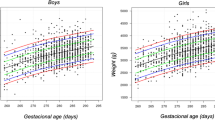Abstract
Introduction
Abnormalities in maternal serum marker levels and fetal measurements obtained during the first trimester screening can be a marker not only for certain chromosomal disorders and anomalies in the fetus but also for specific pregnancy complications. In particular, low maternal serum pregnancy-associated plasma protein-A (PAPP-A), at 11–13 weeks of gestation, is associated with stillbirth, infant death, intrauterine growth restriction, preterm birth, and pre-eclampsia in chromosomally normal fetuses, while a raised nuchal translucency is associated with specific structural abnormalities and genetic syndromes. We have studied the serum Papp-A level in 560 pregnant patients (11–13 weeks gestation) registered at Bharati Hospital and Research Centre, Pune. All patients undergoing testing were followed till the delivery and their neonatal outcome was also taken into consideration.
Aims and Objectives
Our aim is to study the pregnancy outcome in relation to the variations of Papp-A level in the first trimester of pregnancy.
Materials and Methods
Every patient visiting the antenatal OPD was counseled for testing of First Trimester Screening to assess fetal well-being. Patients who were registered for delivery at our hospital were taken into the trial. Blood samples were taken at 11–13 weeks of pregnancy and sent to the PerkinElmer lab for analysis. Results were expressed in Multiple of Median and patients having MOM value less than 0.5 were carefully observed till the delivery, and a thorough neonatal examination was done by a pediatrician.
Observations
524 patients were included in the trial out of which 452 patients were found to have a normal Papp-A level of >0.5 MOM. All these patients were followed further during the antenatal period where 18 patients developed preterm labor and few patients developed pregnancy-induced hypertension. The obstetric outcome of patients with a normal Papp-A level was fairly uneventful as compared to others with a low Papp-A level.
Conclusions
Though Papp-A level in the first trimester of pregnancy (11–13 weeks) is an important predictor of future obstetric outcome, it has poor positive predictive value. Patients having a Papp-A level less than 0.5 MOM have a high risk for preterm delivery, fetal growth restriction, and stillbirths along with increased incidence of hypertensive disorders of pregnancy. A low Papp-A level is a useful indicator of risk of preterm delivery and future chance of development of pregnancy-induced hypertension.


Similar content being viewed by others
References
Proctor LK, Toal M, Keating S, et al. Placental size and the prediction of severe early-onset intrauterine growth restriction in women with low pregnancy-associated plasma protein-A. Ultrasounds Obstet Gynecol. 2009;34(3):274–82.
Gagnon A, Wilson RD, Audibert F, et al. Obstetrical complications associated with abnormal maternal serum marker analytes. J Obstet Gynaecol Can. 2008;30(10):918–49.
Jacob A, Canick JA, Messerlian GM et al (2010) Pregnancy outcomes predicted by serum markers assayed in Down syndrome screening.
Krantz D, Goetzl L, Simpson JL. Association of extreme first-trimester free human chorionic gonadotropin-beta, pregnancy-associated plasma protein A, and nuchal translucency with intrauterine growth restriction and other adverse pregnancy outcomes. Am J Obstet Gynecol. 2004;191(4):1452.
Spencer K, Cowans NJ, Chefetz I, et al. First-trimester maternal serum PP-13, PAPP-A and second-trimester uterine artery Doppler pulsatility index as markers of pre-eclampsia. Ultrasound Obstet Gynecol. 2007;29(2):128–34.
Filippi E, Staughton J, Peregrine E, et al. Uterine artery Doppler and adverse pregnancy outcome in women with extreme levels of fetoplacental proteins used for down syndrome screening. Ultrasound Obstet Gynecol. 2011;37(5):520–7.
Cnossen JS, Morris RK, Riet G, et al. Use of uterine artery Doppler ultrasonography to predict pre-eclampsia and intrauterine growth restriction: a systematic review and bivariable meta-analysis. CMAJ. 2008;178(6):701–11.
Handschuh K, et al. Low PAPP-A: what are the clinical implications? Placenta. 2006;27(Suppl A):S127–34.
Bowman CJ, Streck RD, Chapin RE. Maternal-placental insulin-like growth factor (IGF) signaling and its importance to normal embryo-fetal development. Birth Defects Res B. 2010;17:10–8.
Kirkegaard I, Uldbjerg N, Oxvig C. Biology of pregnancy-associated plasma protein-A in relation to prenatal diagnostics: an overview. Acta Obstet Gynecol Scand. 2010;89(9):1118–25. doi:10.3109/00016349.2010.505639.
Ultrasound Obstet Gynecol 2006;28:637-43.
Cowans NJ, Spencer K. First-trimester ADAM12 and PAPP-A as markers for intrauterine fetal growth restriction through their roles in the insulin-like growth factor system. Prenat Diagn. 2007;27(3):264–71.
Dugoff L, Hobbins JC, Malone FD, et al. First-trimester maternal serum PAPP-A and free-beta subunit human chorionic gonadotropin concentrations and nuchal translucency are associated with obstetric complications: a population-based screening study (the FASTER Trial). Am J Obstet Gynecol. 2004;191(6):1446–51.
Author information
Authors and Affiliations
Corresponding author
Rights and permissions
About this article
Cite this article
Patil, M., Panchanadikar, T.M. & Wagh, G. Variation of Papp-A Level in the First Trimester of Pregnancy and Its Clinical Outcome. J Obstet Gynecol India 64, 116–119 (2014). https://doi.org/10.1007/s13224-013-0481-4
Received:
Accepted:
Published:
Issue Date:
DOI: https://doi.org/10.1007/s13224-013-0481-4




